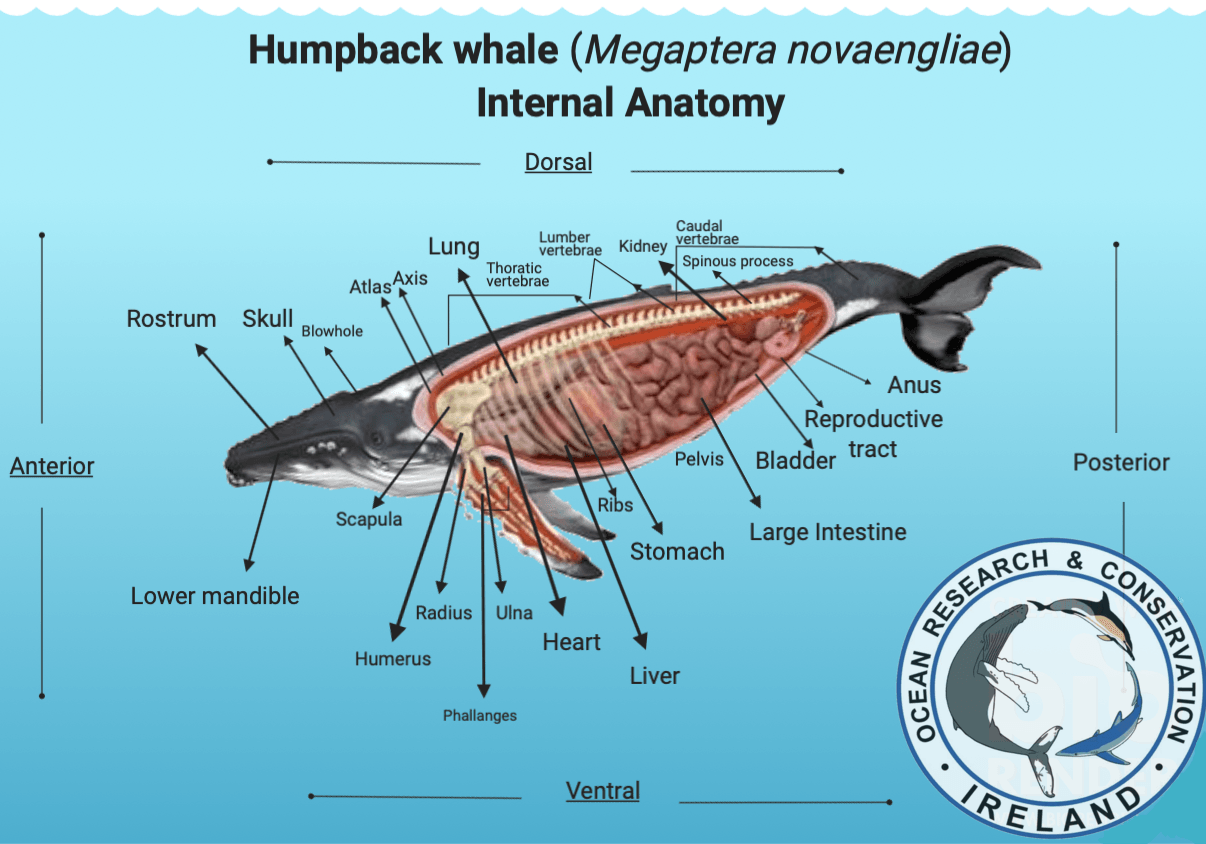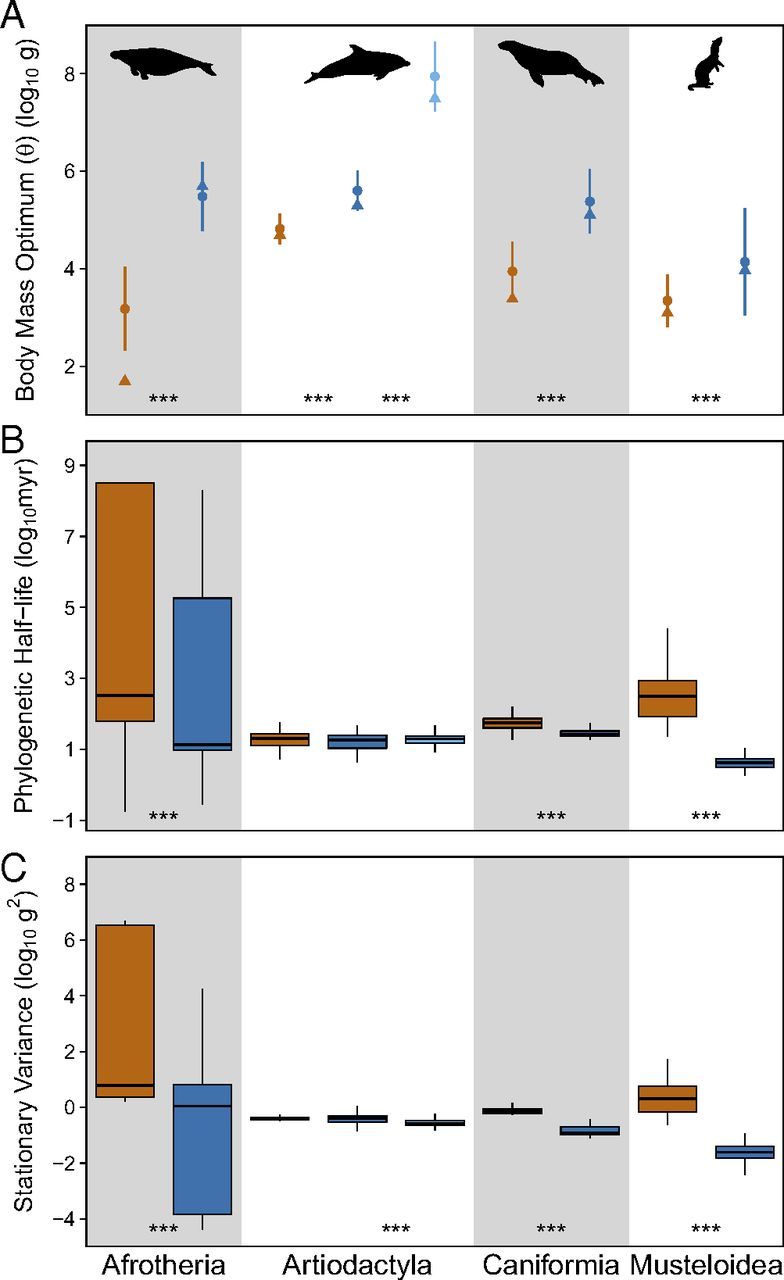How humpback whales survive in the marine environment: Part II
Whales are marine mammals, which means they breathe air, give birth to live young and suckle their calves with milk. They have the largest organs in the animal kingdom, for example, a humpback whale's four-chambered heart weighs as much as three times the average size of a humans. So how do they use their specialised large organs to survive in the marine environment?
Fig 1. Internal anatomy of Megaptera novaengliae. Copyright Ocean Research & Conservation Ireland.
Cetaceans (whales, dolphins and porpoises) all share several common and unique characteristics that allow them to survive and prosper in oceanic environments.
A whales digestive system includes the stomach , the intestines and the liver.
The stomach of baleen whales comprise of three main compartments. The first and second compartments (fore-stomach and main stomach) are wide and can hold at least 200 gallons and possibly up to a ton of krill or small fish. Whales have a stomach similar to that of cattle, deer, and sheep, which also have three stomach compartments. The large and small intestine does not differ in size like in other mammals. A whale's liver is two-lobed, whereas humans have a four-lobed liver. The lobes of both human and whale livers are of unequal size. Whale liver is sold as food in Japan.
A whales respiratory system; the Lungs and the blowholes —Note that the trachea leads to the nostrils on the top of the head. A whale's lungs are surprisingly small in proportion to the rest of their bodies, as due to the depths to which whales dive and the accumulation of potentially harmful gases, it would actually be dangerous for whales to have large lungs.
A baleen whale breathes air through two blowholes at the top of its head, the air enters the lungs, oxygenates the blood and travels through the body to other tissues. The gases in the air dissolve in the fluids of the body. These gases include nitrogen. As a whale descends deeper in the water column, air becomes more and more compressed. This forces increased gases to be dissolved into the tissues. If the lungs were very large, more gases (e.g. nitrogen) would be absorbed, which could create toxicity in the body. In addition, if the whale ascended too quickly with all that gas absorbed in the tissues and not enough in the lungs, it could lead to decompression sickness ( also known as the "bends").
The ribcage is very flexible and can expand but more importantly can cave in under pressure, preventing the lungs from collapsing. As pressure is increased on the lungs, air leaves and pushed into the bronchioles so that the alveolar sacs may collapse. In the bronchioles, no gas exchange takes place, protecting the tissues from being exposed to concentrated amounts of nitrogen.
Whale's do not need to store oxygen in their lungs to survive. They can store a large percentage of oxygen in circulated blood around their bodies. Humans need to store approximately 36% of the oxygen that we inhale into the lungs, whales, however, can store about 75% of their oxygen in their circulatory system.
A whale can hold it's breath for 10 to 60 minutes, depending on the species. On average, a humpback whale dive can last between 10 and 30 minutes.
A whales circulatory system; the heart is four-chambered like that of other mammals. There are left and right ventricles and auricles, a pulmonary artery and vein, and an aorta. Among mammals, the whale has the widest heart, and it is slightly flattened and rounded at its apex (tip). The muscle walls of the ventricles (two lower heart chambers) of several large whales have been measured from 7.6 to 12.7 cm in thickness. Whales slow their heart rate down when taking a deep dive. For example, a whale's pulse rate has been estimated at 60 to 140 beats per minute, dropping to 4 to 15 beats per minute when diving.
A whales excretory system: Kidneys are located in the top of the body cavity, one on each side of the spinal cord area. They are lobulated, which means they look like a huge bunch of grapes tightly packed together.
Analysis of humpback whale reproduction system, or reproductive tracks from individuals that breed in Pacific waters suggests they give birth to one calf every 2-3 years.
Whale's are the largest mammals on Earth, but new research published in the Proceedings of the National Academy of Sciences
has suggested that their body size growth is restricted by the need to retain heat and to get enough food to survive. While it is commonly thought that pressures on body size would be more relaxed in water , because of the large environment and the animals ability to float rather than have to support their body weight on legs, however; "It's not that water allows you to be a big mammal, its that you have to be a big mammal in water- you don't have any other options", said co-author of the study, Jonathan Payne, a professor in Stanford's School of Earth Energy and Environmental Sciences.
So how does a whale's large size help them to survive in the oceans. The latest theory suggests that the larger size of these marine mammals allows them to retain heat in seawater which is lower than body temperature. Smaller mammals loose heat back into the water quickly. In addition, metabolism increases with size, which can be greater than an animals ability to find nutrients, putting a boundary on how big a marine mammal can grow. Thus, under a robust energetic model, it has been shown that thermoregularity costs constrain minimum size, whereas limitations on feeding efficiency constrain maximum size (Gearty et al.,
2018).
Fig 2. Box Plots of estimated body mass optima: (A) phylogenetic half-lives, (B) stationary variances (C) by clade and habitat type. Colour coding to habitat type (orange ; terrestrial, dark blue; toothed marine mammal, light blue; Baleen whale.
References:
Gearty, W., McClain, R., Payne, J.L (2018) Energetic tradeoffs control the size distribution of aquatic mammals. Proceedings of the National Academy of Sciences.
© Ocean Research & Conservation Ireland (ORCireland) and www.orcireland.ie , est. 2017. Unauthorized use and/or duplication of this material without express and written permission from this site’s author and/or owner is strictly prohibited. Excerpts and links may be used, provided that full and clear credit is given to Ocean Research & Conservation Ireland and www.orcireland.ie with appropriate and specific direction to the original content.
SHARE THIS ARTICLE















